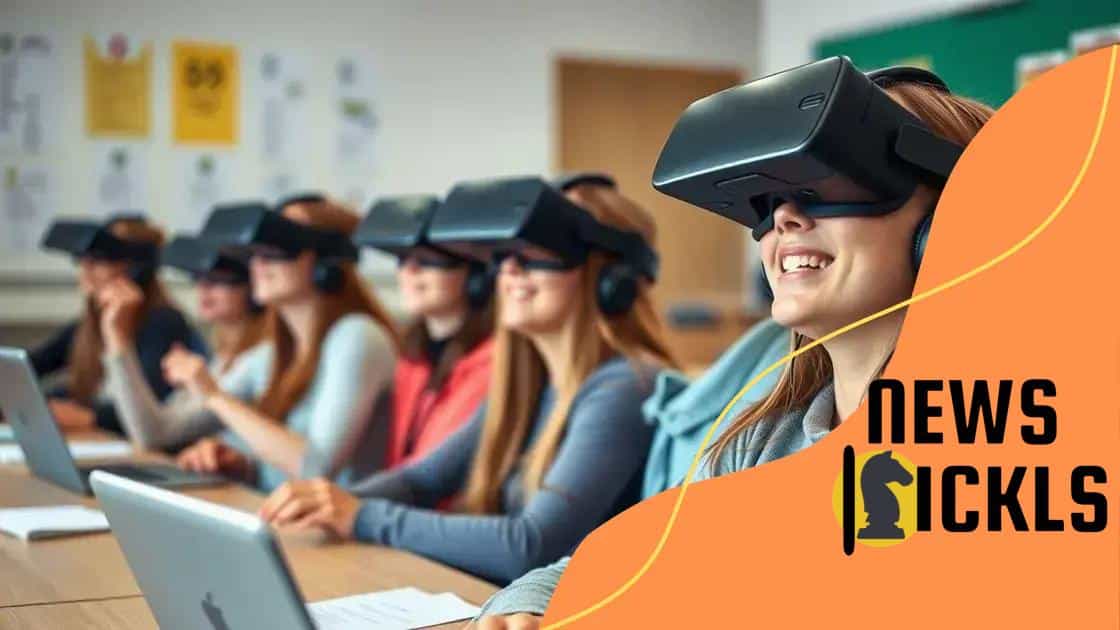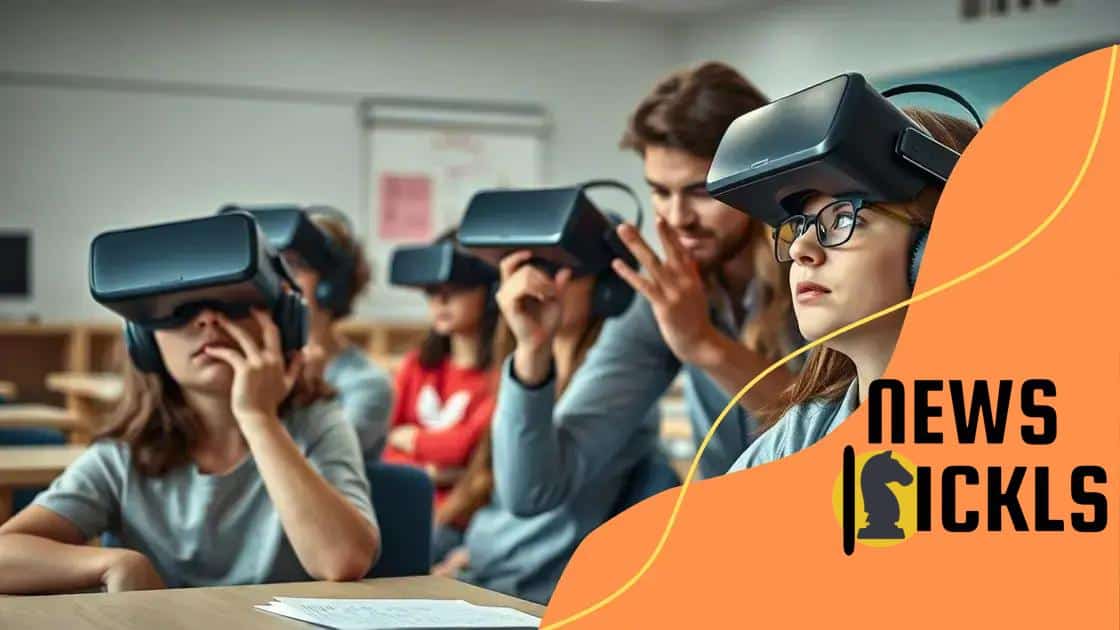How VR is transforming language learning experiences

VR is transforming language learning by providing immersive experiences, enhancing engagement, and allowing real-life practice with native speakers, ultimately improving retention and fluency.
How VR is transforming language learning experiences is a fascinating topic that highlights the shift in educational methodologies. Have you ever imagined learning a new language in a virtual world? This article explores how immersive technologies are reshaping education.
Understanding VR in language learning
Understanding how VR is changing language learning is crucial in today’s educational landscape. Virtual reality immerses students in engaging environments that mimic real-world scenarios, making it easier to grasp new languages.
This technology allows learners to engage with native speakers in virtual settings, which can boost confidence and speaking skills. Imagine practicing French in a virtual Paris, surrounding yourself with the language and culture.
Key Features of VR Language Learning
There are several important features of VR that facilitate effective language acquisition.
- Immersive experiences: VR creates an interactive and stimulating environment.
- Real-time feedback: Learners receive immediate corrections and suggestions.
- Cultural exposure: Students gain insights into the culture associated with the language.
With these key aspects, learners can deepen their understanding and retain information better. More so, VR presents a unique opportunity to practice in a safe space without the fear of making mistakes. Learners can repeat exercises until they feel comfortable.
Additionally, VR applications often incorporate gamification, making language practice enjoyable. As learners progress through levels, they feel a sense of achievement. This playful approach to learning helps keep motivation high.
The Role of Teachers in VR
Teachers play an integral role in implementing VR in language education. They can facilitate discussions, provide guidance, and help students navigate the technology effectively.
Moreover, instructors can round out VR experiences with traditional teaching methods, ensuring comprehensive education. This balance helps reinforce lessons learned in virtual environments.
Benefits of immersive learning environments
Immersive learning environments offer numerous benefits that significantly enhance the language learning process. These environments provide students with opportunities to practice their skills in realistic settings, promoting engagement and retention.
When learners are surrounded by realistic scenarios, they tend to pick up new vocabulary and phrases more effectively. The use of immersive technology allows for interactive experiences that traditional classrooms may lack.
Key Advantages of Immersive Learning
There are several key advantages of using immersive learning environments for language education.
- Enhanced engagement: Students become more involved when learning feels like an adventure.
- Improved retention: Real-world practice helps solidify knowledge in memory.
- Opportunities for practice: Learners can converse with virtual characters and simulate everyday interactions.
Furthermore, immersive environments reduce the anxiety that often comes with speaking a new language. In a virtual world, learners can make mistakes without fear of judgment. This safe space encourages experimentation and boosts self-confidence.
Additionally, these environments can cater to different learning styles. Visual learners benefit from engaging visuals, while auditory learners thrive with interactive audio components. As students navigate through different activities, they can discover which methods work best for their needs.
Real-World Applications
Immersive learning environments are not just theoretical; they are used in various educational settings around the globe. Educational institutions are leveraging VR and AR technologies to create dynamic classrooms.
Teachers can design custom scenarios that mimic real-life situations where students need to communicate. This hands-on practice prepares learners for encounters in the real world, such as traveling or conducting business in a foreign language.
Challenges of adopting VR in classrooms

Adopting VR in classrooms presents several challenges that educators must address to ensure successful implementation. While immersive technology has many benefits, the transition to virtual environments can be complex.
One significant challenge is the cost associated with VR equipment and software. Schools may struggle to secure the necessary funding to provide every student with access to these tools. Additionally, maintaining the technology can become costly as well.
Technical Issues in the Classroom
Another challenge involves technical problems that may arise during VR sessions. Software glitches or hardware failures can disrupt lessons and frustrate both teachers and students. Moreover, teachers need to be familiar with the technology to address any issues promptly.
- Training needs: Educators require training to effectively use VR tools.
- Infrastructure requirements: Schools must have compatible systems and internet access.
- Support systems: Ongoing technical support is essential for smooth operation.
Moreover, the physical space in classrooms needs to accommodate VR activities. Students require enough room to move around safely, which can be challenging in smaller classrooms. As a result, educators must plan carefully to create an effective learning environment.
Another aspect to consider is the curriculum integration of VR technologies. Teachers must develop lesson plans that incorporate VR thoughtfully and meaningfully. This process can be time-consuming, especially when aligning with existing educational standards.
Student Readiness
Not all students may be ready to engage with VR technology, either due to varying levels of comfort or experience with digital tools. Some may feel disoriented or overwhelmed by immersive environments, which can hinder their learning experience.
Additionally, schools need to implement strategies to support students who may struggle with VR. This includes providing alternative resources and options for learners who may not connect with the technology as effectively. Addressing these varied needs can pose a significant challenge for educators.
Tips for integrating VR tools effectively
Integrating VR tools effectively into the classroom can greatly enhance the learning experience. However, this requires careful planning and execution to ensure that both teachers and students benefit from the technology.
First, educators should start small. Trying to implement too much VR at once can overwhelm both teachers and students. Introduce one or two VR applications that align closely with the curriculum. This allows for focused integration without causing confusion.
Aligning with Learning Objectives
It’s essential to align VR activities with specific learning objectives. This practice ensures that the use of VR supports educational goals rather than distracts from them. Teachers can design lesson plans where VR experiences reinforce concepts being taught in class.
- Identify learning goals: Clearly outline what students should learn from the VR experience.
- Select appropriate content: Choose VR tools that match the identified goals.
- Assess student comprehension: Use assessments to evaluate how well students grasp the material.
Moreover, fostering a collaborative environment can be beneficial for VR integration. Encourage students to work in pairs or groups when using VR. This approach not only makes the experience more engaging but also promotes teamwork and communication skills.
Additionally, providing adequate training for teachers is crucial. Instructors need to feel comfortable using VR technology to facilitate effective lessons. Professional development sessions can equip educators with the skills and confidence necessary to maximize the use of VR in their classrooms.
Gathering Feedback
Once VR tools are implemented, collecting feedback from students can guide improvements. Understanding their experiences helps educators make necessary adjustments and enhance future lessons. Encourage students to share their thoughts on what they liked and what challenges they faced.
By regularly gathering feedback and adjusting strategies, teachers can ensure that VR remains a valuable part of the learning process. This ongoing evaluation not only improves lessons but also keeps students engaged and excited about learning.
Future trends in VR language education
Future trends in VR language education promise to revolutionize how students learn new languages. As technology advances, educators are exploring innovative ways to enhance language learning through immersive experiences.
One exciting trend is the use of artificial intelligence (AI) paired with VR. Integration of AI can help create personalized learning paths for students. With adaptive learning technologies, VR can adjust to individual progress, ensuring that each learner faces appropriate challenges.
Expansion of Realistic Environments
Another significant trend is the development of more realistic virtual environments. As VR technology evolves, the immersion becomes deeper. Students may find themselves in vibrant cities or bustling marketplaces, making language learning feel authentic.
- Customizable settings: Educators can design settings that match specific vocabulary themes.
- Cultural simulations: Experiences can include cultural nuances, enhancing understanding.
- Multi-sensory experiences: Future VR could incorporate touch and smell, making learning richer.
The future of VR language education also aims to foster global collaboration. Virtual classrooms can connect students from different countries, promoting cultural exchange and authentic communication. This interaction allows learners to practice speaking with native speakers, improving fluency and confidence.
Furthermore, as educators gain more training, the integration of VR becomes more seamless. Schools will likely provide professional development opportunities, ensuring teachers understand how to leverage these tools effectively. As this process continues, the quality of VR language education will undoubtedly improve.
Gamification in Learning
Gamifying language learning experiences is another trend gaining traction. By incorporating game elements into VR, students often feel more motivated. They can earn points, unlock levels, and even compete with classmates.
This playful aspect encourages participation, making learning enjoyable. With new challenges introduced in games, students may stay engaged longer, resulting in greater retention of vocabulary and grammar.
FAQ – Frequently Asked Questions about VR in Language Education
What are the main benefits of using VR in language learning?
VR provides immersive experiences that enhance engagement, increase retention, and allow for real-life practice in a safe environment.
How can teachers effectively integrate VR tools in their classrooms?
Teachers can start small by introducing one or two VR applications, aligning them with learning objectives, and providing proper training to enhance their effectiveness.
What challenges might educators face when adopting VR technology?
Challenges include high costs, technical issues, the need for adequate training, and ensuring the classroom environment supports the use of VR.
How does gamification enhance language learning through VR?
Gamification makes learning more enjoyable by incorporating game-like elements, motivating students to participate and stay engaged throughout the learning process.






